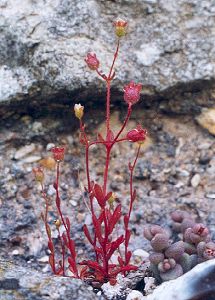Defiantly resisting the sea at the northern end of Portsmouth Harbour, the outer walls of Portchester Castle are the best preserved Roman walls in Europe. Inside are later buildings, mostly medieval. English Heritage have been custodians of the castle since 1984, and have produced a booklet detailing its history of human occupation. From a natural history viewpoint, a structure of this age might be expected to have acquired some interesting inhabitants. The most accessible parts are the Roman walls, the L-shaped ditch and the outer walls of the medieval inner bailey. Old photographs show that the walls and towers were once host to a lot of ivy, but climbing plants are now kept under control. Judging from the nature of the vegetation along the base of the walls, a weed-killer is used occasionally.
Common plants on the walls are Wallflower, Red Valerian and Pellitory-of-the-wall. Scattered on the inside and outside of the Roman walls is a fern, Wall-rue (Asplenium ruta-muraria). This was once used to help combat rickets, because of its calcium content.
Described below are some other plants on the walls.

Botanically, the castle's claim to fame is Thick-leaved Stonecrop (Sedum dasyphyllum), in its only known location in Hampshire. This plant can be found in various places on the Roman walls. It is native to southern Europe, and regarded as an escaped garden plant here.
Visible only in early summer is the tiny annual plant pictured on the right, Rue-leaved Saxifrage (Saxifraga tridactylites).
Two different looking ferns grow on the round bastions. Maidenhair Spleenwort grows on one near the narrow northern entrance, while Black Spleenwort is more common, growing on the western side. Also on this side, near the ground is Fern Grass, a short grass which looks a bit like a fern.
Keeping the sea out, at least for the present, is a sea-wall built in 1936. Small gaps in the wall provide anchorage for Golden Samphire and Rock Sea Spurrey. Apart from plants, the castle (probably the medieval keep) is home to unknown species of bats, which have been seen during evening events.